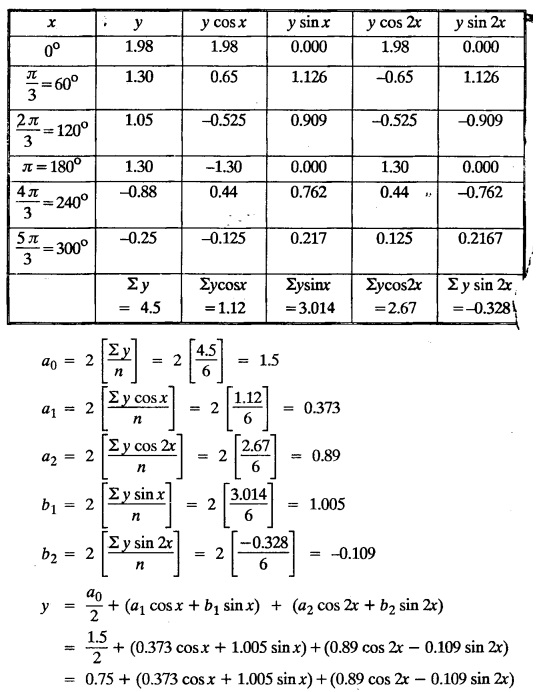Transforms and Partial Differential Equations: Unit II: Fourier Series
Harmonic Analysis
Definition, Formula, Solved Example Problems | Fourier Series
Sometimes the function is not given oy a formula, but by a graph or by a table of corresponding values.
HARMONIC ANALYSIS Sometimes the function is not given oy a formula, but by a graph or by a table of corresponding values. The process of finding the Fourier series for a tabular form of numerical values is known as Harmonic Analysis. The Fourier constants are evaluated by the following formulae : Fundamental or first harmonic. The term (a1 cos x + b1 sin x) in Fourier series is called the fundamental or first harmonic. Second harmonic: The term (a2 cos 2x + b2 sin 2x) in Fourier series is called the second harmonic and so on. Note: Type 1 : Given data are in л form Type 2 : Given data are in degree form Type 3 : Given data are in T form Type 4 : Given data are in l form Problems based on Harmonic Analysis TYPE 1: GIVEN DATA ARE IN л FORM Example 2.6.1 : Find the Fourier Series upto the third harmonic for y = f (x) in (0, 2π) defined by the table of values given below. Solution: Since the last value of y is a repetition of the first, only the first six values will be used. We know that the Fourier series. is given by The values of y cos x, y cos 2x, y cos 3x, y sin x, y sin 2x, y sin 3x are tabulated below. Example 2.6.2 : Determine the first two harmonic of the Fourier series for the following values. Solution : Example 2.6.3 Find an empirical formula of the form f (x) = a + a1 cosx + b1 sin x for the following data given that f(x) is periodic with period 2 л. Solution : Since the last value of y is a repetition of the first, only the first six values will be used. Example 2.6.4 : Compute the first three harmonies of Fourier series of f(x) given by the following data. Solution: Let the Fourier series upto third harmonic representing f(x) be Example 2.6.5: The values of x and the corresponding values of f(x) over a period T are given below, Show that Solution: First and last values are same. Hence we omit the last value. Example 2.6.6 : Find the first two harmonics of the Fourier series from the following table. Solution : Here, the length of the interval is 2l = 6, i.e., l = 3. ⸫ The Fourier series can be represented by 1. The following values of y give the displacement in cm of a certain machine part of the rotation x of the flywheel. Expand ƒ (x) in the form of a Fourier series. 2. The displacement ƒ (x) of a part of a machine is tabulated with corresponding angular moment 'x' of the crank. Express f(x) as a Fourier series upto third harmonic. 3. Find the Fourier series as far as the second harmonic to represent the function given by table below: 4. Find the Fourier series upto second harmonic representing the function given by 5. Find the Fourier series upto second harmonic representing the function given by 6. Find the Fourier series upto second harmonic representing the function given by 7. Find the Fourier series upto third harmonic representing the function given by 8. Obtain the first three co-efficients in the Fourier cosine series for y, where y is given in the following table 
 are the amplitudes of the first and second harmonic. The amplitudes A1, A2, will decrease rapidly. Hence, the first few harmonics give a good result to the given function.
are the amplitudes of the first and second harmonic. The amplitudes A1, A2, will decrease rapidly. Hence, the first few harmonics give a good result to the given function. 




TYPE 2: GIVEN DATA ARE IN DEGREE FORM




TYPE 3 : GIVEN DATA ARE IN T FORM



TYPE 4. GIVEN DATA ARE IN / FORM


EXERCISES 2.6 [Harmonic Analysis]








Transforms and Partial Differential Equations: Unit II: Fourier Series : Tag: : Definition, Formula, Solved Example Problems | Fourier Series - Harmonic Analysis
Related Topics
Related Subjects
Transforms and Partial Differential Equations
MA3351 3rd semester civil, Mechanical Dept | 2021 Regulation | 3rd Semester Mechanical Dept 2021 Regulation
